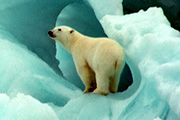Status and Population

Click image to enlarge.
Historic status
Several polar bear populations were decimated by unsustainable hunting by European, Russian and American hunters and trappers from the 1600s right through to the mid-1970's.
In 1973 commercial hunting was strictly regulated following the signing of an international agreement on polar bear conservation.
Current Bear Populations
- 20-25,000 polar bears worldwide
- Aproximately 19 distinct sub-populations (see above map)
- 60% of these are in Canada
- Tracks have been reported as far north as the pole
- Few scientists believe few bears travel beyond 82กใ north latitude. This is because the northern Arctic Ocean has little food for them.
Today, polar bears are among the few large carnivores that are still found in roughly their original habitat and range, and in some places in roughly their natural numbers.
Although most populations have returned to healthy numbers, there are differences between the populations. Some are stable, some seem to be increasing, and some are decreasing due to various pressures. There are large uncertainties regarding some populations that are still harvested quite heavily and others for which information is lacking.
Conservation Status
In 1973, Canada, the United States, Denmark, Norway and the former USSR signed the International Agreement on the Conservation of Polar Bears and their Habitat.
In 2005, the IUCN Polar Bear Specialist Group (PBSG) reviewed the status of polar bears using the IUCN Red List categories and criteria.
The group concluded that the Red List classification of the polar bear should be upgraded from Least Concern to Vulnerable based on the likelihood of a decline in the total global polar bear population of more than 30% within the next 35 to 50 years.
The US Government has classified the Polar Bear under its Endangered Species Act (ESA).
The main cause of this projected decline in polar bear numbers is climatic warming and its consequent negative effects on the sea ice habitat of polar bears.
This agreement on the status of polar bears regulates hunting and habitat protection, but it does not protect bears against the biggest man-made threat to their survival: global warming.
If current warming trends continue unabated, scientists believe that polar bears will be vulnerable to extinction within the next century.
